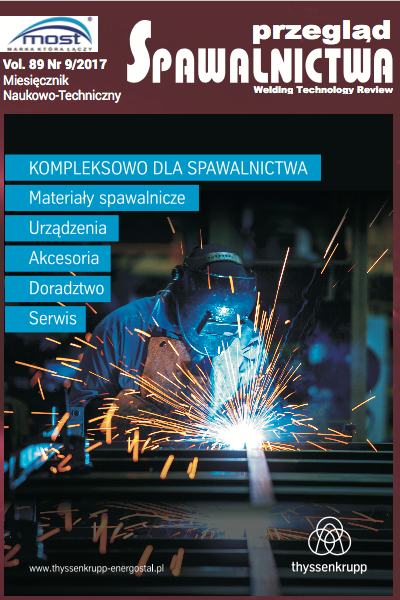Hybrid nodepredictions of angular distortion of the connector on the basis of three dimensional designed experiment
Main Article Content
Abstract
The article presents the results of experimental researches on angular distortion of the connector of a hybrid node. The hybrid node being a part of the large-size steel structure is formed as a result of joining I-core panel with conventional stiffened steel plate. The researches has been carried out according to design of experiment technique in laboratory conditions near-real-life production conditions. The presented analysis accounts for technological-constructional parameters influencing the suitability for assembly of a hybrid node. The presented appraisal method used for experiment results features implementation of approximation dependence to predict angular distortion in large-size steel constructions.
Downloads
Article Details
Creative Commons CC BY 4.0 https://creativecommons.org/licenses/by/4.0/
Welding Technology Review (WTR) articles are published open access under a CC BY licence (Creative Commons Attribution 4.0 International licence). The CC BY licence is the most open licence available and considered the industry 'gold standard' for open access; it is also preferred by many funders. This licence allows readers to copy and redistribute the material in any medium or format, and to alter, transform, or build upon the material, including for commercial use, providing the original author is credited.
References
T. Urbański: Węzeł hybrydowy technologiczność wielkogabarytowych konstrukcji spawanych wprowadzenie, Przegląd Spawalnictwa Vol. 82 (11), s. 21-25, 2010.
T. Urbański: Węzeł hybrydowy prognozowanie odkształceń spawalniczych panelu I core na podstawie planowanego eksperymentu dwuwar- tościowego, Przegląd Spawalnictwa Vol. 84 (3), s. 16-22, 2012.
T. Urbański: Węzeł hybrydowy prognozowanie skurczu poprzecznego złącza doczołowego na podstawie planowanego eksperymentu dwuwartościowego, Przegląd Spawalnictwa, Vol. 87 (11), s. 22-26, 2015.
T. Urbański: Metoda prognozowania odkształceń spawalniczych węzła hybrydowego na podstawie badań eksperymentalnych, Rozprawa doktorska, Zakład Konstrukcji, Mechaniki i Technologii Okrętów, Wydział Techniki Morskiej, Zachodniopomorski Uniwersytet Technologiczny w Szczecinie, Szczecin 2009.
R. R. Iwańkowicz: An e cient evolutionary method of assembly sequence planning for shipbuilding industry, Assembly Automation, Vol. 36 (1), pp. 60-71, 2016.
Shipbuilding and Repair Quality Standard IACS, London 1996: Part A. Shipbuilding and Repair Quality Standard for New Construction; Part B. Repair Quality Standard for Existing Ships.
Norma zakładowa: T100-1, 2001. Stalowy kadłub statku. Dokładność konstrukcji kadłuba, Stocznia Szczecińska S.A.
B. Metschkow: Współczesna technika utrzymywania wysokiej jakości konstrukcji okrętowych, X Konferencja: Laboratoria technologiczne aspekty utrzymania wysokiej jakości wyrobu, Wydawnictwo Uczelniane Politechniki Szczecińskiej, Szczecin 1999.
B. Metschkow, T. Graczyk: Laser welded joints in shipbuilding, Second International Conference On Marine Technology ODRA 1997, Szczecin 13-15 May 1997, ed. Computational Mechanics Publications, Southamp- ton & Boston 1997.
D. C. Montgomery: Design and analysis of experiments, John Wiley & Sons, Inc. fth edition, New York, 2001.
Z. Polański: Planowanie doświadczeń w technice, PWN, Warszawa, 1984.
Norma zakładowa: T081-02, Spawanie łukowe w osłonie gazów ochronnych, część II Instrukcje technologiczne spawania WPS, Stocznia Szczecińska S.A. 2001.
H. Remes, P. Varsta: Statistics of weld geometry for laser-hybrid welded joints and its application within notch stress approach, Welding in the World, Vol. 54 (7), pp. 189-207, 2010.
Y. P. Yang, H. Castner, R. Dull, J. Dydo, T. D. Huang, D. Fanguy, V. Dlugokecki, L. Hepinstall: Complex-panel weld shrinkage data model for neat construction ship design engineering, Journal of Ship Production and Design, Vol. 30 (1), pp. 15-38, 2014.
Y. P. Yang, H. Castner, R. Dull, J. Dydo, D. Fanguy: Uniform-panel weld shrinkage data model for neat construction ship design engineering, Journal of Ship Production and Design, Vol. 29 (1), pp. 1-16, 2013.
N. R. Draper, H. Smith: Applied regression analysis, John Wiley & Sons, Inc., New York, 1998.
M. Dobosz: Wspomagana komputerowo statystyczna analiza wyników badań, Akademicka O cyna Wydawnicza EXIT, Warszawa, 2004.
E. Kołodziński: Symulacyjne metody badania systemów, PWN, Warszawa, 2002.
W. Oktaba: Elementy statystyki matematycznej i metodyka doświadczalnictwa, PWN, Warszawa, 1974.
T. Urbański: Analysis of assembly suitability of the hybrid node based on weld distortion prediction models, Advances in Science and Technology Research Journal Vol. 9 (27), pp. 28-34, 2015.
